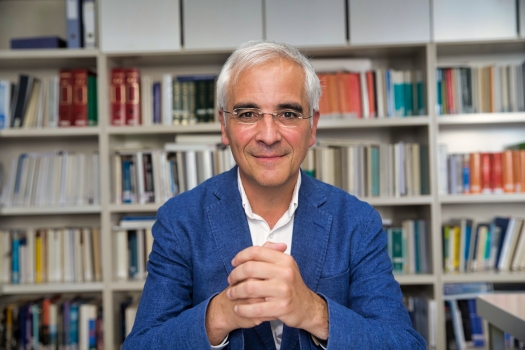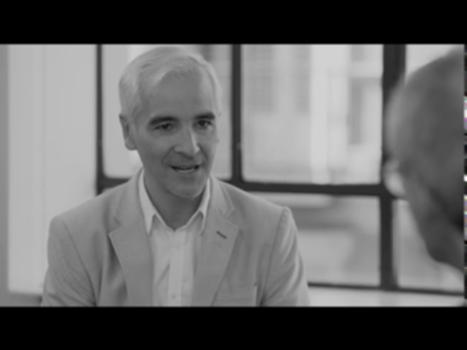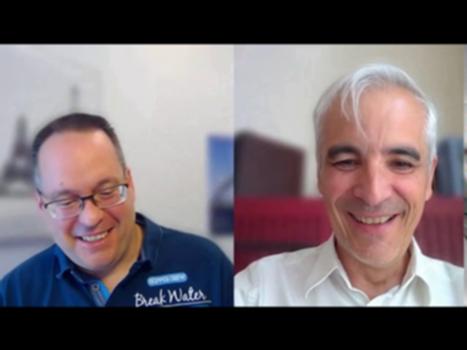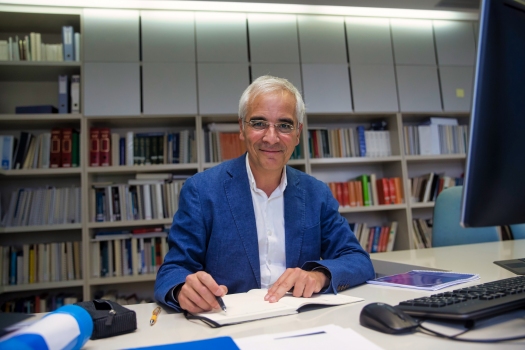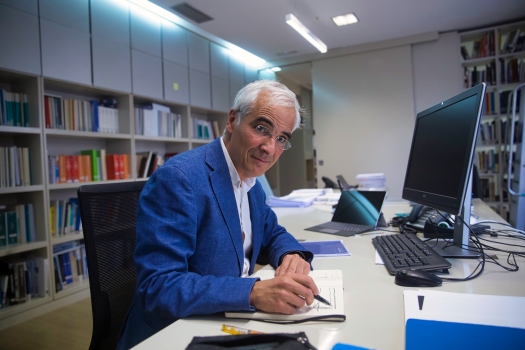Spanish civil engineer, structural and bridge designer, and professor.
Biographical Information
| Name: | José Romo |
|---|---|
| Full name: | José Romo Martín |
| Born on | 30 April 1959 in Madrid, Madrid, Spain, Europe |
| Place(s) of activity: |
|
| 2008 | ACHE Spanish Concrete Association Medal |
Seven Questions for José Romo
Structurae's chief editor, Nicolas Janberg, asks José Romo seven questions about bridge design, the Mersey Gateway Bridge and sustainability.
Why did you decide to become a civil engineer?
José Romo (JR): Well, I was, from childhood, I was interested in construction, in seeing how things work. And when I had to decide my profession, I was doubting about studying architecture or civil engineering. I was very interested in the two professions. I think they are quite similar in a way. But probably, I think, the decision was mainly driven by the nature. Because I think civil engineers working in the nature. So we are doing things in the landscape and this attracted me more than just building in a city. So I this was a probably the main interest because I am interested in art and also in architecture, but I think this working in nature, in the landscape, is what’s probably the main point for deciding to be a civil engineer instead of an architect.
Nicolas Janberg (NJ): This is the first time I'm hearing that as a reason for becoming a civil engineer. […] Are you still happy as a civil engineer?
JR: Yeah. I'm very happy working as civil engineer. I think we have in one side all the technical tools that are interesting and all the knowledge of technical things, but we can apply in real work for doing things that people can use. So this is a very attractive situation and that's why I'm very happy to have studied structural engineering and have the possibility to design bridges, in my case.
Which kinds of structures have you designed and which types of structures do you prefer working on?
JR: Well, I have been working in architecture as civil engineer, structural engineer. So I have been doing complex structures. Normally in buildings, the structures are more complex than bridges. They are complex systems with limited space. So it's normally a very challenging project for a civil engineer. And at the same time. I think it working with architects in buildings is also a good training as designer because you can see their point of view, more general, more holistic, that you can apply in your profession as a bridge designer. I’m also very happy to do it bridges and it’s this type of structures that I prefer to work on because you have the possibility to design, to interact with the landscape and with the road or the railway and all this is a very, very attractive. So I have the chance to design several bridges and I'm very happy to follow in this.
NJ: How long have you been designing?
JR: I have been designing for more than 30 years. So it's a long time and so I had a chance to design any kind of structures from arches to cable-stay bridges, suspension bridges, all kinds of structures and with different materials. Also this is interesting. And also working in existing structures. So what is this also a very nice topic and a very nice field to work in.
How many bridges have you designed in all that time? And how many of those were built? And do you have any favorites?
JR: I have no precise number or record of bridges. Probably more than 50 or something like that any kind. So normal bridges on also special bridges and well, I'm very fond of all the typologies and all the structural types. So there is no a favorite for me. As a designer, you know, you prepare a lot of competitions or designs and probably from that only, let‘s say one third, pass to the state of the designing of the project itself. And then from this probably 50 percent are built at the end. So normally you have more ideas than done projects and more projects than real bridges. This is a pity, but this also is a part of the profession or game, in a way?
NJ: So do you have any designs that you really would like to be built at some point but haven't gotten around to?
JR: Yeah for sure. Yeah.
What is your experience with cable-stayed bridges and do you like designing them?
JR: I have the chance to design three or four cable-stay bridges, a small one and big ones. I think probably it’s the more sculptural structure you can design as a civil engineer, because they are very visible. They have some challenges from the technical point of view, but also from the aesthetical point of view because they are very prominent. The politician likes this kind of structures because they are very visible in the cities, they are normally a landmark, but they are not easy and that way because you have to define a structural more very visible, very efficient at the same time. So a lot of constraints and you can do a very ugly cable-stay bridge see if you don't care enough in the design phase so I like to work in this field and it's a very challenging, as they say.
NJ: So the biggest cable-stayed bridge you designed was the Mersey Gateway, right?
How did you get involved with the Mersey Gateway project? And what was your role in the project?
JR: This was a design and build project, and the constructors were a team of three constructors: one from Spain, FCC, and Kier from UK, and Samsung from Korea. Well, the Spanish constructor wanted us to be part of the design members, the design JV to work on this, and that's why we were involved in that. We were brought to the team probably of our experience in concrete structures, because it's a very important concrete deck with a very wide, with complex screens and stuff like that. So in my case, I was part of the JV members and also I was part of the of the small team that had the chance to design the concept. So in our case it was a small group, I was part of this group, with some people from the Dissing and Weitling, they were the architects for the final design, and also people from COWI and that were also part of the team in this design phase. So mainly my task was part of the design team. Let's say the core for the concept and the developping of the of the main idea.
NJ: The bridge won the IABSE Outstanding Structure Award, so it must be a special bridge. Can you explain why?
JR: When you see the bridge, probably, you‘ll find it a little bit weird, because they have a pile on the pylon of the other central pylon is more than the flanking one. But it was a really more of a question of the line in the environment conditions because just to maintain the lateral flow of water in the Mersey, you have the big lateral spans and then the rest was just by symmetry and just by construction. So it was very driven by the environment condition and the same time the construction and the structural efficiency.
Well, the first is the second continuous cable-stay bridge made in concrete in the world. So it's a big one and also was a record also in concrete deck in the UK. So the configuration is very special because in continuous cable-stayed bridges you have to control the deformation of the lateral spans by different methods. Normally, you just put in some anchorage cables or some other methods. In our case, we use this small central tower to control the deformation. So we have a fixed point in the center. So this is a concept that was new, and was special in this case, well, taking advantage that we have only two main cable-stayed spans. And also an important point was the construction. For building the bridge we made a jetty and temporary bridge to access to all the points. So there was a very careful study during the tender phase to achieve, to diminish the interference with the environment, which was very sensitive.
NJ: I'm assuming you a very proud of the result.
JR: Yes, I'm very proud of the result. I think, all the team, also the architects, and the rest of the team from COWI and ourselves, we were very, very proud of the bridge. I think it‘s a landmark in this part of England and I think it also is a way of showing, which is important in my case, I was very, with the Architects also, we were very aware of the approach viaducts. Because probably in this case, this was a one of the key points that we use the same cross-section across the full estuary. So this gives to the bridge a kind of uniformity from the structural point of view because this have only expansion joints in the abutments, but also from the static point of view and construction. So at the end we have a very robust concept that I think fits very well in the landscape.
Yeah, that's my main criticism of a lot of longer bridges that the main Bridge looks perfect. But then the approaches are terrible.
Yeah. And in this case, even we have a variable cross-section the with but with the ribs we use the were able to have a variable cross-section and you probably will not notice from very far. But it was a very uniform view. So this, I think, one of the key points of the design.
NJ: You're you're very interested in sustainability and bridge construction.
How do you deal with sustinability when comes to designing bridges?
JR: Well, from my point of view, the sustainability starts with the concept. The concept has to be robust for now and for the future. So this is the most important thing. And also when you design a bridge you sometimes have the possibility to select the position of the bridge in the town or crossing a river. So you are fixing things. So you are interacting with the future. So this is very important in our case, let's say in structural engineering applied to bridge, I think this is probably more important than other things like CO2 because we are using both two materials, I will say, concrete and steel, and normally the decision of the material is mainly driven by the span range or the access and other things. We don't have too many possibilities when we decide the materials. I think this is quite different from architecture where you have the façade, you have the way of dealing with energy consumption, etc. So this is a quite different approach, I would say. And in our case I think, it‘s more the efficiency, and when you design the bridge you use the minimum of materials, the minimum interference with nature, and the way of doing things, considering the water, but I think this is probably more important than just small things with cutting the CO2 or this stuff. I think this is more important, the position of the bridge, the height of the bridge, compared to with the water to consider, probably, the climate change and how it will affect your bridge or your communication system. So for me, this is more important than other things and I think sustainability from the bridge design is more related to efficiency of materials, a proper way of dealing with nature, and also doing something that is robust in concept, that is for now and for the future. And in many cases it‘s just using or re-using structures. I think the more sustainable way of designing is reusing existing structures, because you have something there and you have only to refurbishment, to up the load, or to bring to the structure a new life. So this is a more efficient way of dealing, really, with sustainability in bridge design. Try to use the material you have or the bridge you have, and try to improve the bridge to be able to serve for 100 years more. This is a very sustainable way of doing things.
Structures and Projects
Participation in the following structures & large-scale projects:
- Badajoz Congress Center - FHECOR
- Irún Footbridge - FHECOR
- Júcar River Bridge - FHECOR
- Mersey Gateway Bridge - FHECOR
- New Montoro Bridge - FHECOR
- Rambla del Cañuelo Bridge - FHECOR
- Rio Fuengirola Footbridge - FHECOR
- Riudellots High-Speed Rail Bridge - FHECOR
- Roof over the Plaza de Toros de Pontevedra - FHECOR
- Vinalopó River Bridge - FHECOR
- Zabalgana Footbridge - FHECOR
- Bridge Pavilion - FHECOR
Bibliography
- (2015): Conceptual Design and Aesthetic of Bridges. Presented at: IABSE Conference: Elegance in structures, Nara, Japan, 13-15 May 2015, pp. 48-49.
- (1999): Centro comercial Avenida de las Provincias. Fuenlabrada. Losas postesadas adherentes con vaina oval. In: Hormigón y acero, v. 50, n. 213 (3rd Quarter 1999), pp. 55-61.
- (2006): Concepción estructural, proyecto de construcción y asistencia técnica de las obras de hormigón estructural de los edificios e infraestructuras de la nueva Área Terminal. In: Hormigón y acero, v. 57, n. 239 (1st Quarter 2006), pp. 31-58.
- (1995): Análisis de grandes elementos de hormigón armado. Aplicación práctica del método de las bielas y tirantes. In: Hormigón y acero, v. 46, n. 195 (1st Quarter 1995), pp. 21-33.
- (2010): Cartagena Auditorium facades: a new structural and sustainable skin system. Presented at: IABSE Symposium: Large Structures and Infrastructures for Environmentally Constrained and Urbanised Areas, Venice, Italy, 22-24 September 2010, pp. 806-807.
- About this
data sheet - Person-ID
1009335 - Published on:
12/07/2011 - Last updated on:
19/08/2020

